How to Connect a Wood Burner to Your Central Heating System for a Warmer, Cozier Home
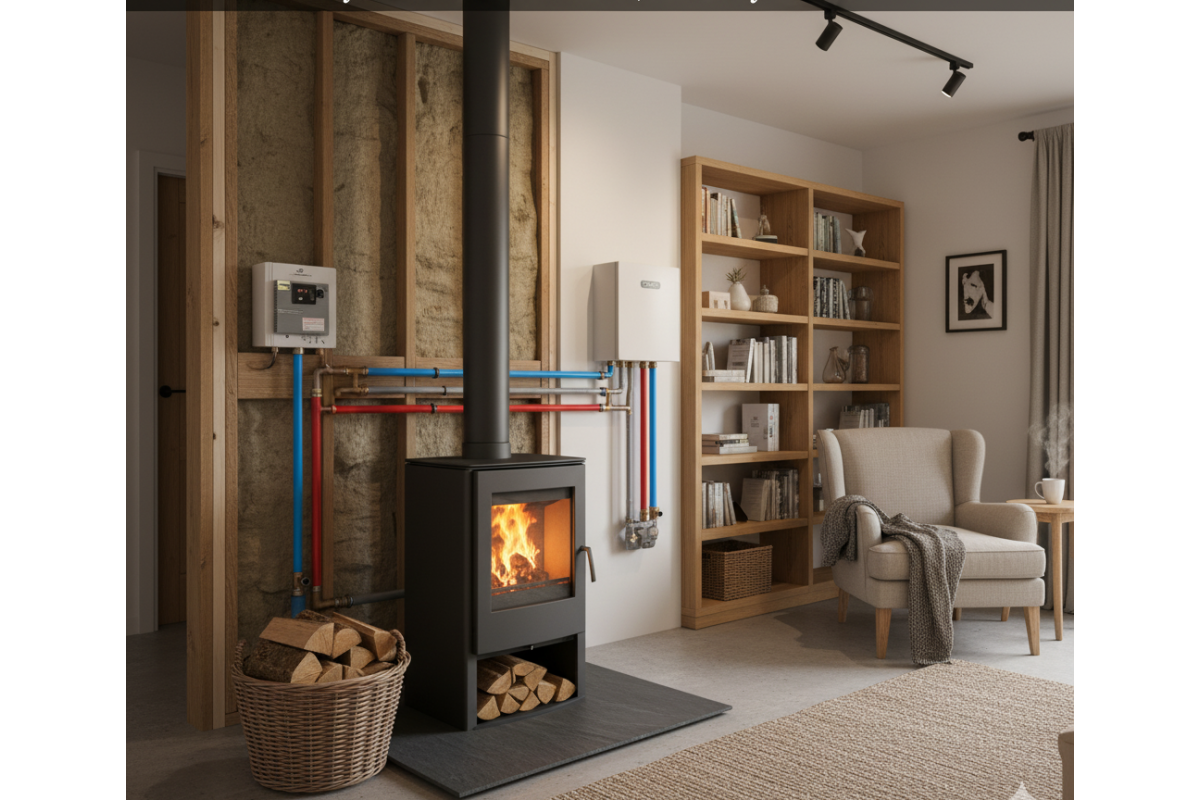
I. Why Solid Fuel is the Smartest Heating Solution Right Now
The Problem: Unstable Energy Costs
The cost to heat a home in the UK keeps going up. As of early 2024, the average annual energy bill sits around £1,928. This upward trend makes many homeowners look for better, cheaper ways to keep warm.
Using a highly efficient wood burner, specifically one with an integrated back boiler, is a powerful answer to high running costs. Wood fuel (logs) is one of the cheapest ways to heat your home.
Logs cost homeowners about 8.4p per kilowatt-hour (kWh). Compare this to electric heating, which can be around 29p per kWh. By switching your main heat source to wood, you could save between £260 and £720 every year. This huge saving is why integrating the heat from your wood burner into your existing radiator network using modern stoves radiators is the smartest upgrade for your property.
What is a Boiler Stove?
A boiler stove is a wood burner that has a back boiler. This boiler is a heat exchanger that sits in the fire chamber. Water flows through this coil, capturing the heat from the burning wood. This captured energy then feeds your central heating water circuit and your hot water supply (DHW).
Modern boiler stoves are very efficient. While older models were often below 70% efficient, today’s engineered models can reach around 80% efficiency.
II. Non-Negotiable Safety and UK Regulations
HETAS and Building Regulations Part
You cannot install a solid fuel heating system yourself and meet the legal safety standards. All installations must follow UK Building Regulations. The key rule here is Approved Document J (combustion appliances).
The safest and most recommended way to ensure compliance is to use a HETAS-certified installer. HETAS is the official body for solid fuel heating. A HETAS engineer can self-certify the work, which confirms your system is safe and legal. This step is mandatory due to the high risks of fire and carbon monoxide (CO).
Critical Safety Devices Checklist
Unlike a gas boiler, a wood burner cannot be instantly switched off. Heat keeps being made until the wood is gone. This creates a risk of the water boiling if the pump stops or all your radiators turn off. UK regulations demand specific safety parts to manage this risk:
- Carbon Monoxide Alarm: Building regulations now require a CO alarm in the same room as the stove. This is a simple but vital piece of equipment.
- The Thermal Safety Valve (TSV): If you have a sealed heating system, a TSV is required. If the water temperature in the boiler gets too high (usually above 95°C), the valve opens automatically. It releases cold mains water into a cooling coil inside the boiler. This cold water quickly removes the excess heat, preventing boiling and dangerous pressure build-up.
- The Heat Dump Radiator (HDR): This is your system’s emergency heat sink. It must be a dedicated radiator permanently connected to the circuit. For safety, the HDR must be plumbed in a way that allows heat to escape even if the electricity fails. It must be installed in a locked open position without any valve that could shut off its flow.
III. Sizing and Matching the Output
Calculating the Heat Load
The goal is to choose a boiler stove that matches your home’s needs. The heat output to the water needs to cover all your radiators and your domestic hot water (DHW).
A simple guide is that you need about 1kW of heat output to water for every average size radiator. An average radiator is typically 1000mm x 400mm.
For example, if a stove sends 12kW of heat to the water, you must first subtract the heat needed for DHW (around 2.5kW). This leaves 9.5kW for space heating. This stove could heat 9 to 10 radiators. Remember to include the mandatory Heat Dump Radiator in your final count.
High-Output ECO Carron Stove- Antique Enamel
A stove that is both aesthetically pleasing and designed for high water output is essential for this project.
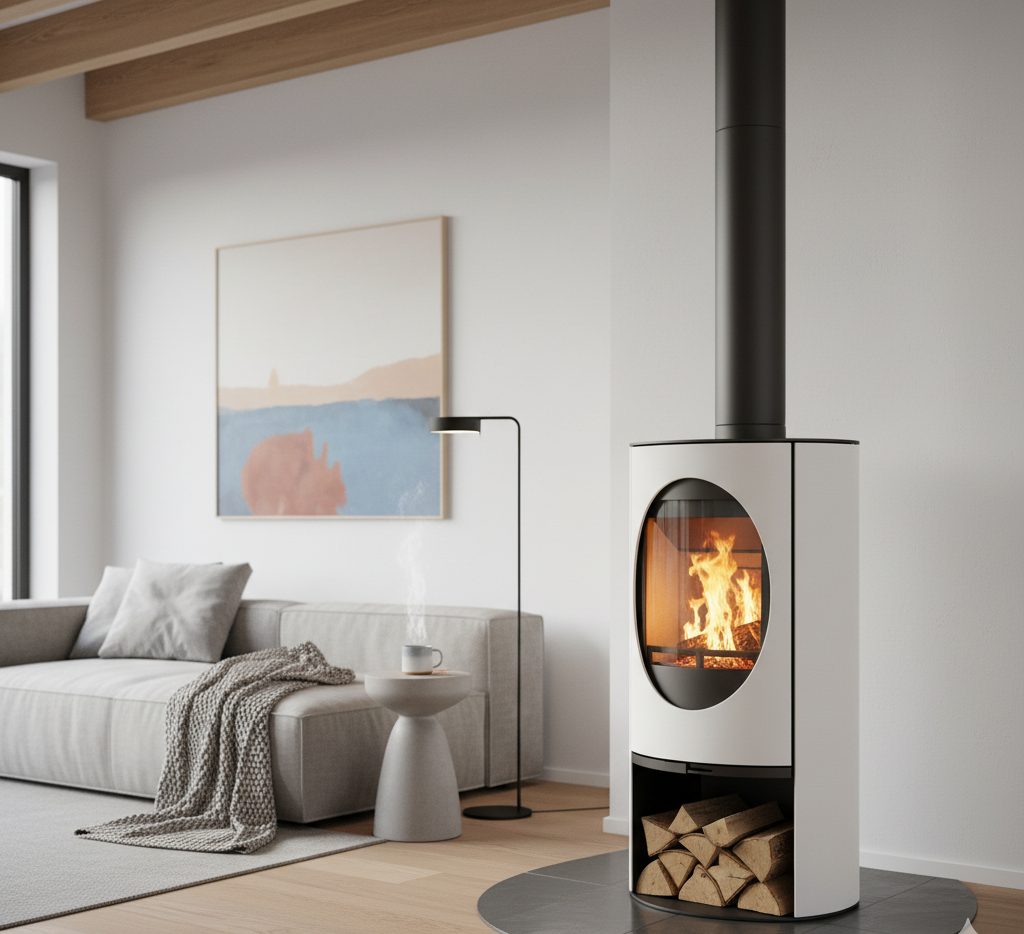
This type of stove provides enough power to drive an entire central heating system.
IV. Plumbing Architecture: Open-Vented vs. Thermal Store
The Prohibition: Combi Boilers
A clear safety warning: wood burners with back boilers are generally not compatible with combi boiler systems. Combi boilers heat water instantly, not by storing it. The constant, high heat output from a stove conflicts with the combi system’s design and pressure dynamics.
Option 1: Open-Vented Systems (Gravity Flow)
Older UK homes often have open-vented systems. These use a header tank (F&E tank) usually in the loft. Safety here relies on a vertical vent pipe that allows boiling water or pressure to escape safely to the atmosphere.
Crucially, this system needs a minimum of two meters of height separation between the stove and the hot water cylinder. This height allows for gravity circulation (thermosyphon). This ensures that even if the power fails, the water can still move naturally to a heat sink, preventing the stove from boiling.
Option 2: The Thermal Store (Modern and Best Practice)
This is the preferred modern method, especially for connecting to a modern sealed system. A thermal store (TS) is a highly insulated tank that acts as a heat battery.
The TS is a form of hydraulic separation. It creates two separate water circuits, safely linking the high-temperature solid fuel side with your regulated radiator system.
The main benefit is that the water stored in the TS is not what comes out of your tap. Instead, the TS uses its stored heat (often 80°C) to instantly heat cold mains water passing through a coil. This gives you strong, mains pressure hot water throughout your home.
For best results, look for a copper thermal store. Copper transfers heat much faster and more efficiently than stainless steel. It also reduces the risk of bacteria.
Recommended Product: Heat Carron stove-Cream Enamel
Every solid fuel system must have an open radiator (Heat Carron stove-Cream Enamel) to manage excess heat safely, as required by law.
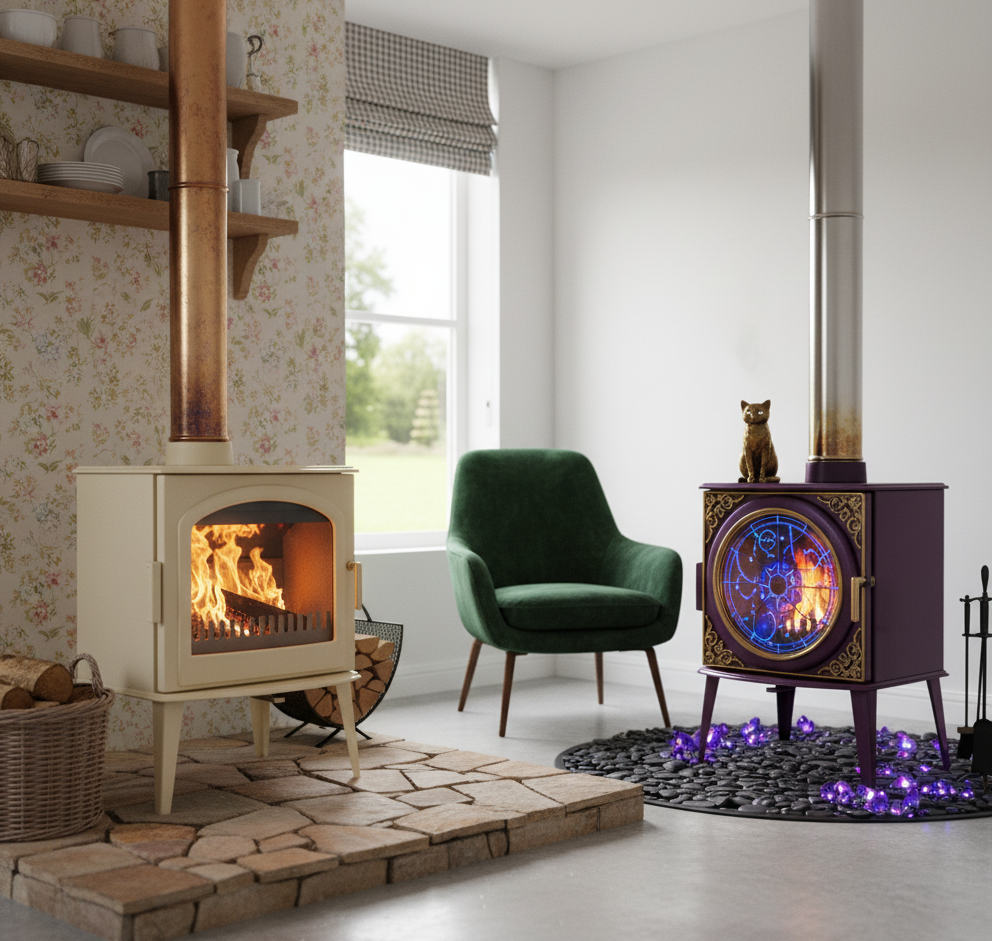
A Heat Carron stove-Cream Enamel is an excellent, efficient choice for this safety circuit.
V. Radiator Selection for Modern Efficiency (Part L)
The 55°C Rule
When you install a new or fully replaced wet central heating system, it must be designed for a maximum flow temperature of 55°C.This is a new rule under UK Building Regulations Part L (2022 amendments), focused on carbon reduction.
This change matters greatly for your radiators. If the water flowing through them is cooler, the radiator needs to be bigger to put out the same amount of heat (BTU). You must choose high-output models.
The Best Radiators for Solid Fuel Systems
- High-Output Panel Radiators: To meet the 55°C rule efficiently, look for Type 22 (K2) or Type 33 (triple panel, triple convector) models. These radiators have a larger surface area to compensate for the lower water temperature.
- Cast Iron Radiators: These are a perfect match for solid fuel. Cast iron holds heat for a very long time, which pairs well with the sustained, long-duration heat from a stove. Because they retain heat so well, you may even need fewer units overall compared to thin panel radiators. Be warned: cast iron is extremely heavy (sometimes over 100kg), so walls often need reinforcement or dedicated floor supports.
Stylish Efficiency: Cast Iron style stove - Rich Red Enamel
Rich Red Enamel offer superior heat retention, ensuring warmth long after the fire has gone out.
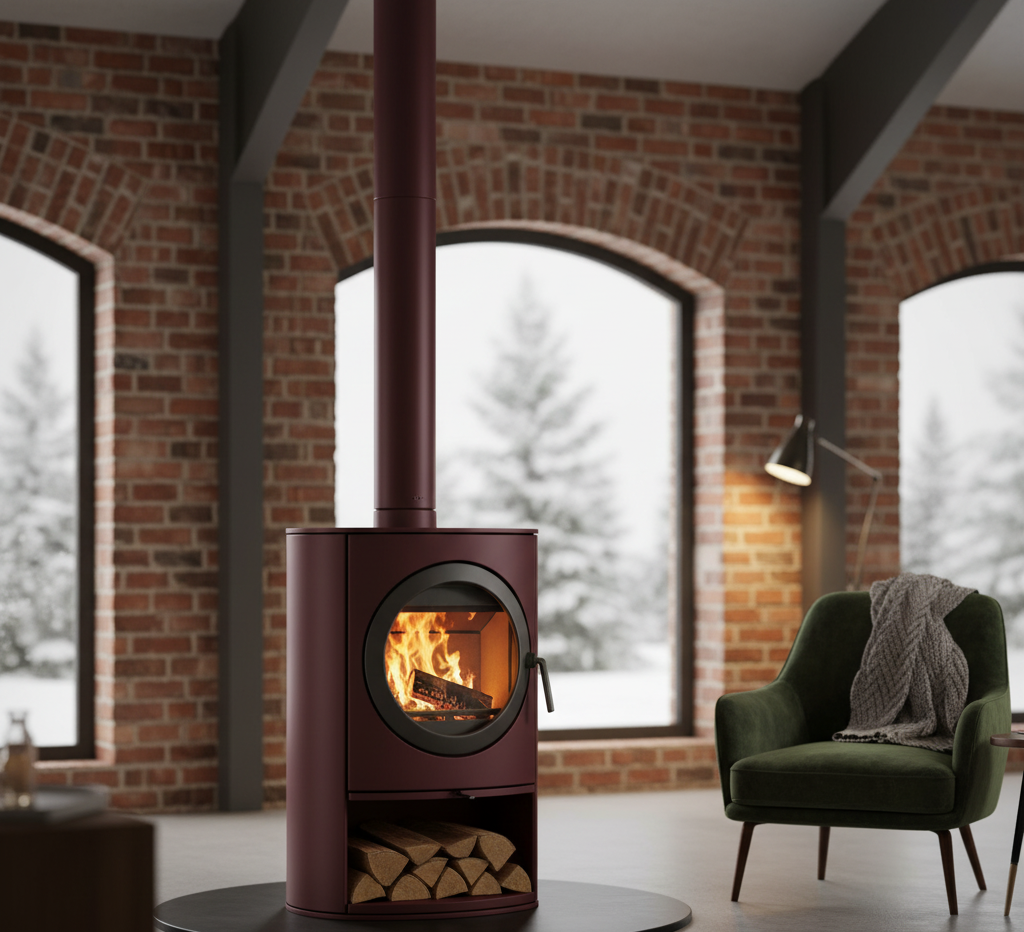
Pairing a boiler stove with Rich Red Enamel units maximizes efficiency and style.
VI. Professional Installation Checklist
Commissioning the System
A HETAS professional must complete a full set of checks to prove the system is safe. This process is called commissioning. It must include:
- Flue Draught Check: The installer must measure the flue draw. If the flue pulls air too hard (overdrawing), the stove cannot shut down properly. This leads to over-firing and reduces efficiency.
- Gravity Circulation Test: The engineer must turn off the circulating pump. They must then log the flow and return temperatures. This proves the water can still move naturally to the heat sink without electricity.
- System Flushing: Both the stove circuit and the main heating system must be thoroughly cleaned. This follows BS 7593 standards. A corrosion inhibitor must be added to protect all metal parts from rust and scale.
- HDR Confirmation: The Heat Dump Radiator must be verified as being in a locked open position.
Installer's Choice: Carron stove - Sage Green Enamel
For maximum heat output at lower flow temperatures, a Sage Green Enamel stove provides superior surface area.
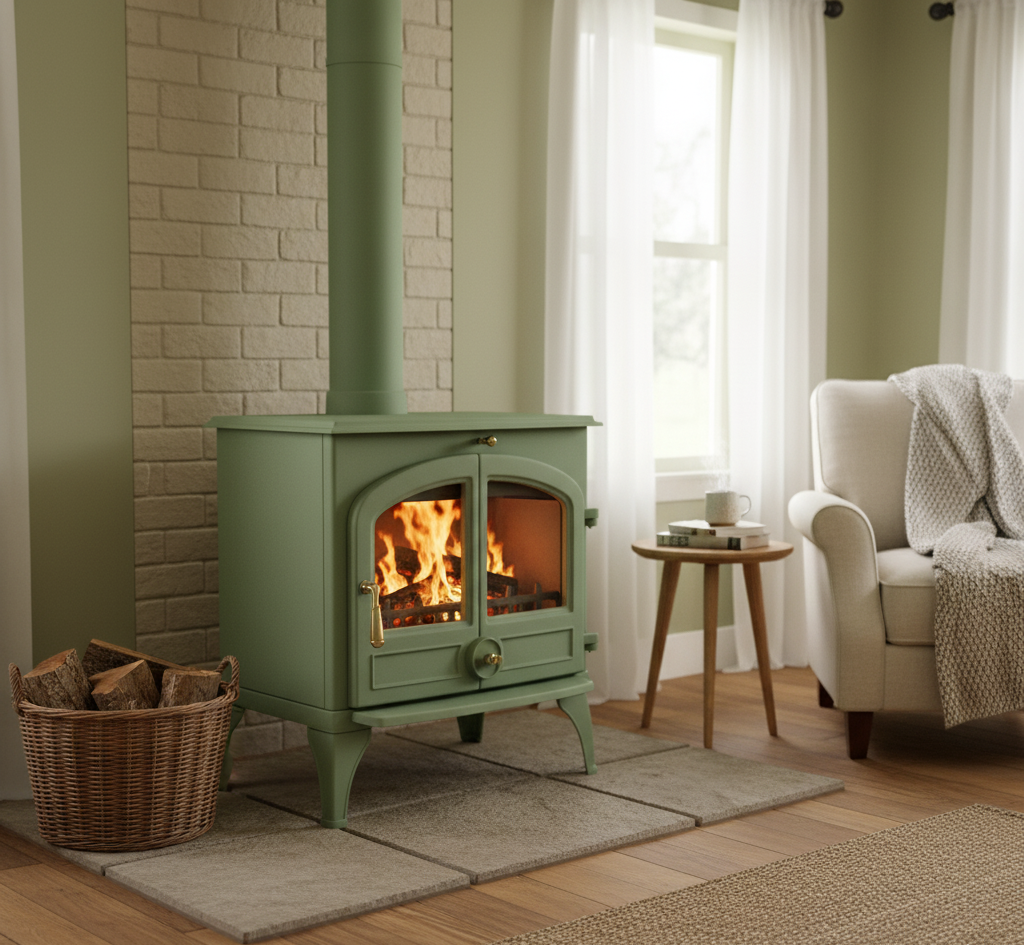
The Sage Green Enamel stove is often specified when matching high-efficiency boiler stoves to modern Part L standards.
VII. Conclusion: Warmth and Resilience
Linking a wood burner with a back boiler to your central heating system is an intelligent way to gain both energy savings and resilience. You switch a large part of your heating load to cost-effective log fuel, while keeping the convenience of a modern radiator network.
Success depends on planning. You must choose the right system architecture the Thermal Store is often best for modern homes. You must follow the strict safety requirements for overheating (TSV and HDR). And you must choose high-output stoves radiators to comply with the 55°C flow rules.
This project is complex and requires professional expertise. Your next step should always be to consult with a HETAS-certified heating engineer for system design and component choice. By following these strict steps, you achieve a warmer, safer, and far more resilient home. Start planning your transition today and secure your savings for years to come.
